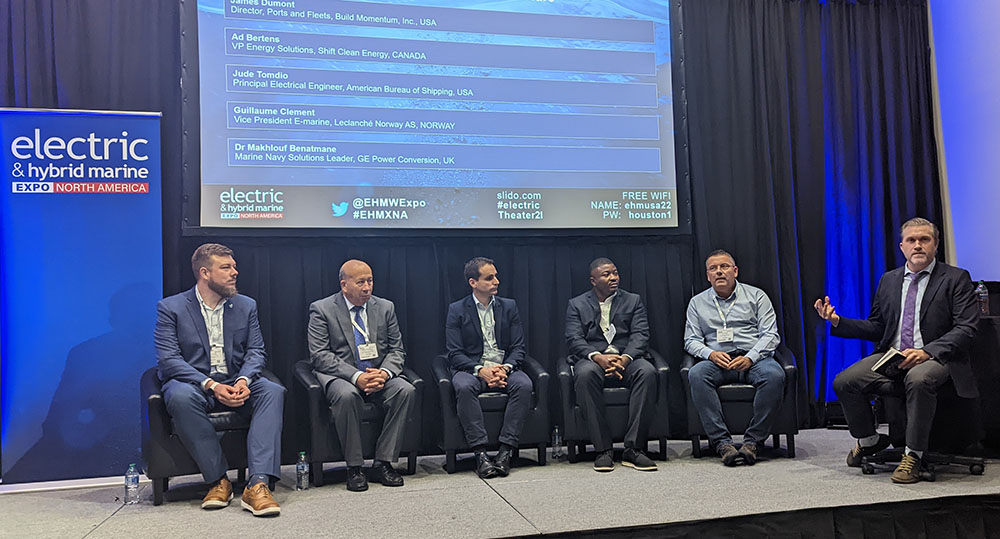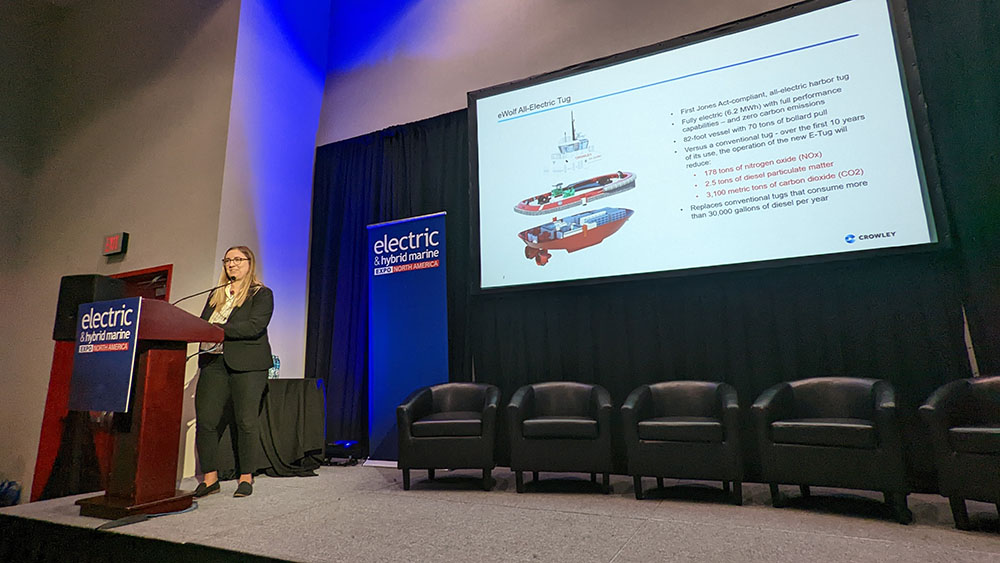The benefits of embracing new hybrid and electric solutions are now better understood, and the logistics associated with adopting them aren’t just about the vessels themselves.
Port electrification may be the single most important factor when it comes to how and where hybrid and electric vessels can be deployed. Thus, it is imperative that port infrastructure continues to evolve.
What are some of the available energy storage solutions for vessels? What design considerations are being utilized as part of the development of recharging solutions? How is legislation driving this evolution?
At the Electric & Hybrid Marine Expo North America Expo held earlier this month in Houston, experts explored what these answers look like in the short and long term.
 Jude Tomdio, a principal electrical engineer at the American Bureau of Shipping (ABS), Houston, provided a powerful perspective on why organizations are going down what can be a challenging path when it comes to electrification.
Jude Tomdio, a principal electrical engineer at the American Bureau of Shipping (ABS), Houston, provided a powerful perspective on why organizations are going down what can be a challenging path when it comes to electrification.
Tomido explained that the three ultimate drives are connected to environmental, commercial and legislative factors. On the commercial side, fuel costs, maintenance and proliferation of ship hybridization are key, he said. On the legislative side, IMO requirements and established federal/state requirements related to emissions are become much more stringent. Some states will soon require vessels and ports to change the way they operate.
“In California, failure to perform specific items in the regulation constitutes a separate violation for each calendar day,” Tomdio said.
Where are we actually seeing these differences though? Green infrastructure can be seen with the all-electric crane at the Port of Los Angeles, all-electric terminal tractors in Philadelphia, Long Beach, Calif., and Tacoma, Wash., and shore power installations in Boston, Seattle, San Francisco and various other cities. The EPA has an electrification tool finder that allows anyone to see all that’s being done: www.epa.gov/statelocalenergy/tool-finder-local-government-clean-energy-initiatives.
James Dumont, director, ports and fleets at Momentum, Sacremento, Calif., detailed how his organization has helped stakeholders design, develop and deploy green solutions for over 450 successful projects that are collectively worth over $6 billion. He discussed the different organizations that developers should have on their shortlist. Major funding partners include federal and state agencies, and local partners.
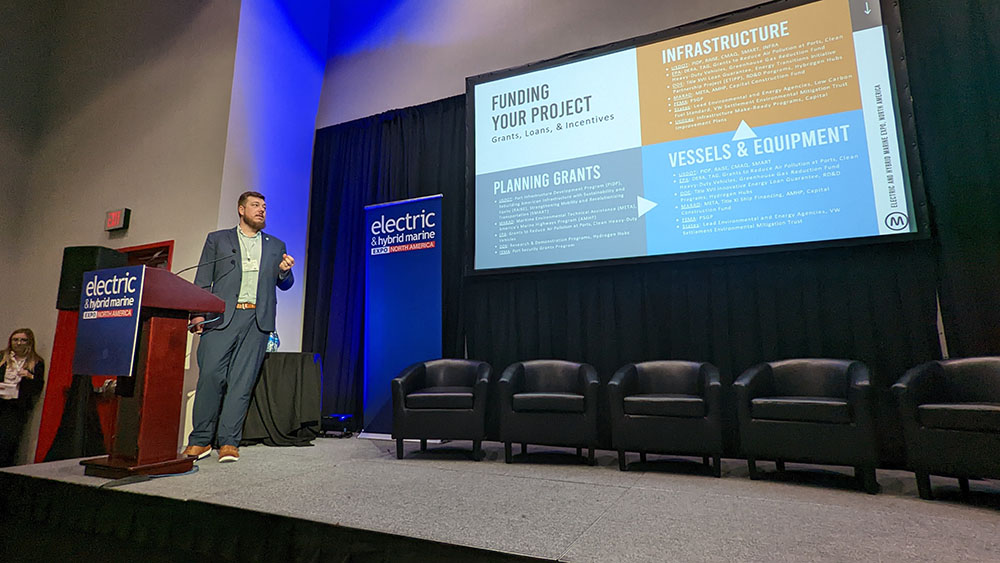
Dumont described these efforts as essential when it comes to the proliferation of electric solutions, as the question of what comes first with electric vessels or infrastructure is an easy answer.
“The infrastructure needs to be in place before any of these electric solutions are going to work,” Dumont said. “You can’t really use an electric car without a space to charge it. The same goes for vessels on the water.”
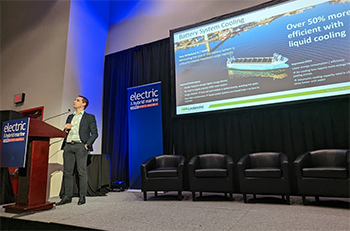 Guillaume Clement, vice president of e-marine at Leclanché Norway AS, Oslo, Norway, described the ways his company has proven the value of electric solutions. While he highlighted specific examples to show how fully electric ferries are the cheapest solutions, he also discussed how the electrification of vessels and ports are reducing greenhouse gases. The specific differences that battery safety systems can enable are stark, and Clement showed the value they have for various vessels in fleets across the world.
Guillaume Clement, vice president of e-marine at Leclanché Norway AS, Oslo, Norway, described the ways his company has proven the value of electric solutions. While he highlighted specific examples to show how fully electric ferries are the cheapest solutions, he also discussed how the electrification of vessels and ports are reducing greenhouse gases. The specific differences that battery safety systems can enable are stark, and Clement showed the value they have for various vessels in fleets across the world.
“Complete systems can be up to 65% less in volume, 50% more efficient, 60% lighter and 55% less demanding on grid power,” Clement said.
Eileen Tausch, senior electrical engineer at Crowley Shipping, provided information about the eWolf, the first Jones-Act compliant, all-electric harbor tug. It is designed to replace conventional tugs that consume more than 30,000 gals. of diesel per year.
Tausch also discussed plans for a Crowley charging station. Currently under design, construction is expected to begin in 2023 and be ready when the eWolf arrives. Adoption will be that much easier with this sort of infrastructure, although it’s just the beginning.
“This charging station is just part of our vision for a future port that has places for hydrogen storage, charging facilities, clean energy scrubber barges and more,” Tausch said.
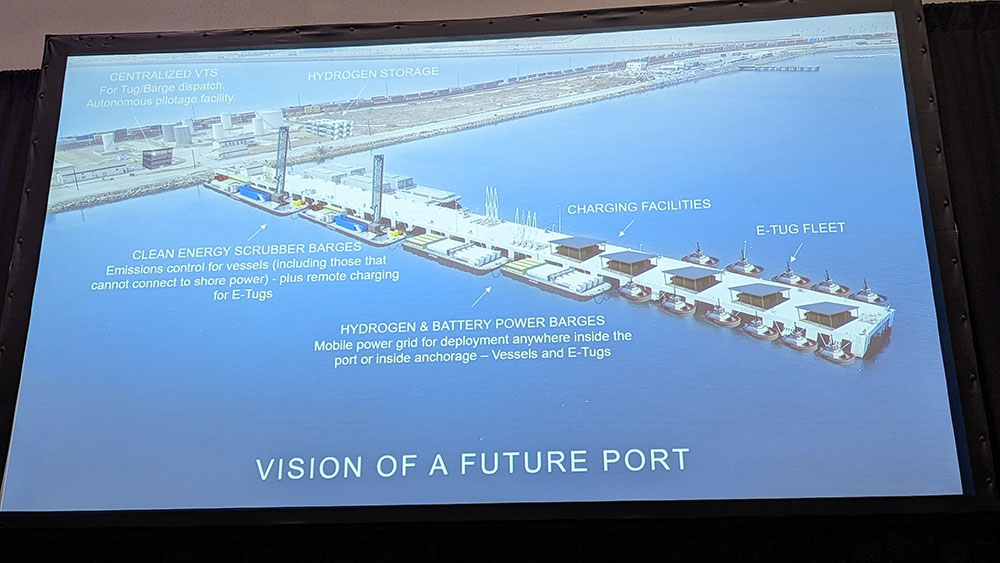
Dr. Makhlouf Benatmane, marine navy solutions leader with GE Power Conversion in the U.K., discussed the importance of networks, specifically the energy grid. Renewables need microgrids and energy storage, not just power network distribution, to be effective, he said. That will require thinking about vessels and the grid itself in a new way.
 “An electric ship is a microgrid in its own right,” Benatmane said. “They will integrate new generation electric. With more ships electrifying, we can create custom grids that enable flexibility, efficiency, future proofing and lower emissions.”
“An electric ship is a microgrid in its own right,” Benatmane said. “They will integrate new generation electric. With more ships electrifying, we can create custom grids that enable flexibility, efficiency, future proofing and lower emissions.”
After the presentations, most of the presenters appeared on a panel moderated by Galen Hon, principal of the PoliSea Group.
“This wide-ranging discussion really shows how much there is to this topic and how much work needs to be done,” Hon said. “That work can’t take place in silos though, so I encourage everyone to keep sharing their insights and learnings with our wider community to ensure our ports are setup to support the latest generation of sustainable vessels.”
